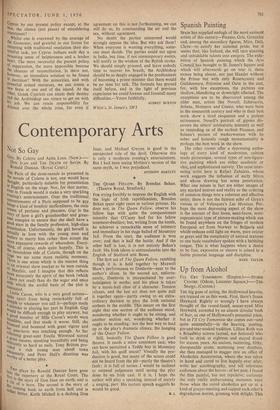Spanish Painting
SPAIN has supplied enough of the most eminent artists of this century—Picasso, Gris, Gonzalez and, among the secondary figures, Miro, Dali, Clave—to satisfy her national pride, but it seems that, like Ireland, she will turn questing and unbiddable talents into emigres. The exhi- bition of Spanish painting which the Arts Council has brought to St. James's Square and which will afterwards go on tour is, these names being absent, not just Hamlet without the Prince but with only Rosencrantz and Guildenstern, Polonius and Osric in the cast, for, with few exceptions, the pictures are shallow, blundering or downright affected. The exceptions are to be discovered among the older men, artists like Nonell, Echevarria, Solana, Mompou and Cossio, who were born in the nineteenth century and who in their best work show a tired eloquence and a patient seriousness. Nonell's portrait of gipsies dis- covers the sitters' aristocratic intensity as well as reminding us of the earliest Picassos, and Solana's picture of washerwomen with its sober and honestly rough monumentality is perhaps the best work in the show.
The other rooms offer a depressing antho- logy of every kind of modernism, cubism made picturesque, several types of non-figura- tive painting which are either academic or chic, and sophisticated naivety. The most inter- esting artist here is Rafael Zabaleta, whose work suggests the influence of early Miros and whose drawing has some penetration. What one misses in fact are either images of any marked interest and reality or the ordering of common.things into a coherent and affective unity; there is not the faintest echo of Goya's visions or of Velasquez's Las Meninas. Per- haps the most depressing aspect of the show is the amount of that loose, semi-fauve, semi- expressionist type of picture-making which can be found anywhere on the fringes of modern European art from Norway to Bulgaria and which reduces cold light on warm, pure colour or greys and the complexity of natural textures to one basic vocabulary spoken with a babbling tongue. This is what happens when a desire to be free, expressive or sincere is joined to a feeble pictorial language and discipline.
BASIL TAYLOR


































 Previous page
Previous page